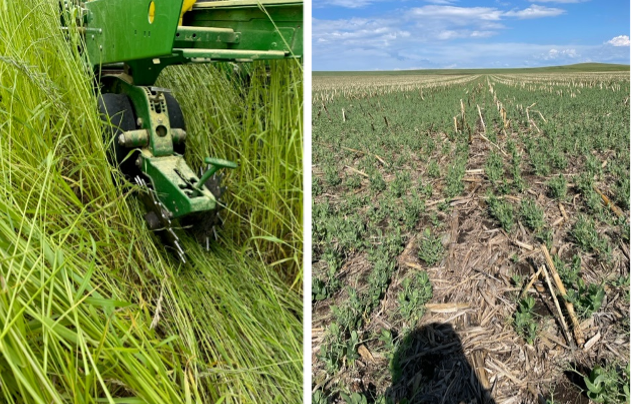by Ethan Begle, Sales & Technical Service Representative
While the simple act of not tilling the soil is becoming more common, there’s a missing piece that will accelerate the benefits: keeping those soils covered. Living roots have multiple benefits that make the no-till system work much better. The first major hurdle with no-till is how to handle compaction. In-line rippers can be a low disturbance way to eliminate deep compaction layers. The issue with this method is ensuring you only do it once (if at all) and being disciplined enough to let the roots and soil biology form the structure from there on. This is where living roots are important as they form the channels to keep soils aerated and feed the soil livestock that then decay and continue the cycle. Living roots all year round prevent the cycles from stopping and all that residue can be a cushion against heavy equipment compacting those soil aggregates. Read this newsletter from March 2013 we shared about compaction as it applies to soil biology. In addition to compaction, roots hold the soil in place to prevent erosion.
There are different ways to keep soil covered as much as possible. Getting perennial grasses and alfalfa into your crop rotation both accomplish this in the best way. Grazing and haying are income possibilities or land can be leased out for those years of the rotation. These deep roots really help the soil long-term and change up the weed pressure in the field. Cover crops help to keep the soil covered between annual crops, and there are many different options when it comes to what to plant. The further north you plant, the fewer options available to get any growth before winter sets in. A young seedling can still accomplish the goal of feeding the soil, so don’t think it’s a waste. Also, if weed control and erosion prevention are important on a particular field, good fall growth will be needed.
This brings us to the next hurdle with cover crops: how to get them seeded early enough and successfully. The easiest and quickest is broadcast with a plane or high clearance rig, but broadcast is too dependent on timely rain to get a good stand. Inter-seeding in corn around V3 has promise up north using ground engaging row units to get seed-to-soil contact. Drilling after harvest is the surest way to a successful and consistent stand of covers but it again limits what species can be used for winter survival. Moving to early-maturity hybrids can mean harvest is earlier in the fall and thus lend more time for cover crops. Having small grains in the rotation really opens opportunities for a warm season cover followed by plenty of time to get winter covers established. Warm season grasses and broadleaves can really help soil health and give a diverse root that further enhances rotation benefits.
There are many more ways to keep roots growing 365 days a year, the above mentioned, are the most common regarding a cropping system. Especially in those tough acres (low yielding), cover-cropping is critical to get things moving in the right direction. With weed resistance only getting worse each year, covers can improve the situation with competition for sunlight. Except cover crops are the plant types we want to have growing to fix specific issues. It’s also important to consider the rotation of plant types (warm-season grass, cool-season broadleaf) etc. when planning rotations. Using a grass cover before a grass cash crop is not ideal when they are used as the only species. However, adding other broadleaves with the grass can give the variation needed to keep the cash crop from becoming a flop. This is when varying root types with cover crop mixes really helps to cover all the bases. Deep tap roots, fine hair roots, broad roots with nodules, they work together to keep things shaded and fix nutrient imbalances.
Furthering this concept of keeping the soil covered is relay-cropping and companion planting. Instead of planting a crop after harvest, inter-seeding the next crop gets an active root growing before the previous crop dies off. This is on top of the benefit of plants sharing resources—which we are still only beginning to understand how much and what the benefits really are with companion plants. This also goes back to cover crops and the multiple benefits attained by striving to have plants growing 365 days. You get erosion control, weed suppression, nutrient cycling, etc. all from an investment in seed.

